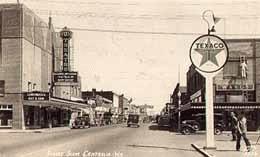On the morning of April 15, 1924, a fire of undetermined origin starts in the basement of the Grand Theatre in Centralia. The blaze causes an estimated $10,000 in damage before it's extinguished, but is confined to non-public areas of the building. The Grand is able to reopen within a matter of days.
Wake-Up Call
Early on the morning of April 15, Frank A. Graham -- owner of the Grand Theatre and living in a suite of apartments within the building -- was awakened by smoke and fire. Acting quickly, Graham hustled his wife and young daughter (still in their nightclothes) out into the street, then called for assistance.
The Centralia fire department responded within minutes and, after a short battle, brought the flames under control.
A Silver Lining?
Although damage to the Grand was extensive (estimated at $10,000, this was quite a hit to a small rural theatre), most of it was confined to the basement and stairway at the rear of the building, leaving the lobby and auditorium relatively unscathed. Graham immediately contracted for repairs, and the Grand was actually able to reopen just four days later, on Friday evening (Tribune).
This was good for Graham’s business, but less so for his home life. Damage to Graham’s apartment was such that the family was not able to return immediately, even after the Grand Theatre itself had reopened.
Business as Usual
The fire put a bit of a damper on Frank A. Graham’s recent business coup. Together with rival exhibitors A. F. Cormier and E. T. Robinson, Graham had just entered into a partnership that gave the men complete control over all six movie houses in Centralia and neighboring Chehalis. (Their partnership would eventually become known as the Twin City Theatres Corporation.)
Their initial holdings included the Grand, Liberty, and Rialto theaters in Centralia, along with the new St. Helens Theatre in Chehalis, which was scheduled to open three weeks after the Grand fire.

